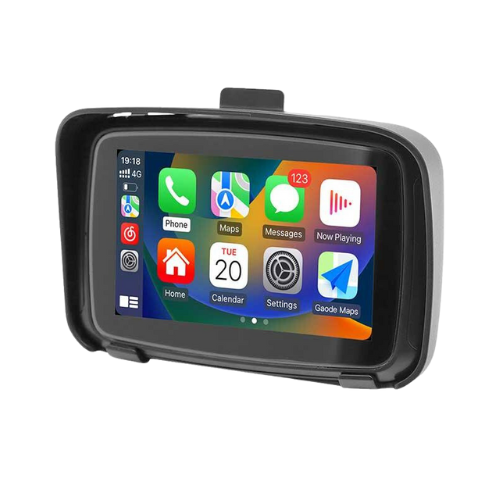In a world where technology intersects with transportation, motorcycle GPS devices have revolutionized how riders navigate the open road. These devices are now essential tools for motorcyclists, offering not only navigation and routing capabilities but also enhancing the overall riding experience with a range of features tailored to modern riders' needs. From planning scenic routes to avoiding traffic jams, a motorcycle GPS ensures that riders have the information they need at their fingertips, making every journey safer and more enjoyable.
The Significance of GPS for Motorcyclists
The importance of GPS technology for motorcyclists cannot be overstated. In the past, riders relied on paper maps and road signs for navigation, often leading to guesswork and unnecessary stops to confirm directions. Today, motorcycle GPS devices provide real-time navigation, route planning, and critical information such as traffic updates, weather conditions, and points of interest. These systems offer unprecedented convenience and efficiency, allowing riders to focus on the joy of the journey rather than navigation logistics.
Moreover, motorcycle GPS devices play a crucial role in enhancing rider safety. With features like turn-by-turn voice directions and hands-free operation, riders can keep their attention on the road, reducing the risk of accidents caused by distractions. Additionally, GPS tracking devices add a layer of security, enabling the location tracking of a motorcycle in case of theft or loss.
Overview of GPS Technology in Motorcycle Riding
GPS technology in motorcycle riding extends beyond basic navigation; it encompasses a wide range of functionalities designed to cater to riders' unique needs. Modern motorcycle GPS systems feature rugged, weather-resistant designs, high-visibility screens readable even in direct sunlight, and battery life suited for extended journeys. These devices seamlessly integrate with other motorcycle technologies, including Bluetooth connectivity for helmet headsets, enabling hands-free communication, music streaming, and audible navigation directions.
The evolution of GPS technology has also brought sophisticated mapping and routing options. Riders can customize routes based on their preferences, whether seeking the fastest, shortest, or most scenic path. Advanced systems adjust routes in real-time, considering traffic conditions and road closures to ensure efficient journeys. For adventure-seeking riders, GPS systems provide off-road mapping and trail tracking, opening up new exploration possibilities beyond paved roads.
In addition to practical applications, GPS technology fosters a sense of community among riders. Many devices and apps allow for the sharing of favorite routes and ride logs, enabling motorcyclists to discover new adventures and connect with others who share their passion for the road.
As we delve deeper into the capabilities and features of motorcycle GPS systems, it becomes clear that this technology is integral to the modern riding experience. It simplifies navigation, enriches the journey, and ensures that every ride is an adventure to remember.
Types of Motorcycle GPS Systems
Navigating the diverse paths and trails on a motorcycle demands reliable guidance, for which riders turn to two main types of navigation aids: dedicated motorcycle GPS units and smartphone GPS apps. These systems cater to riders' varied preferences, ensuring that there's a motorcycle GPS device suited for every journey, whether it's a daily commute or a long-distance adventure.
Dedicated Motorcycle GPS vs. Smartphone GPS Apps
Dedicated motorcycle GPS units are engineered specifically for the demands of motorcycle travel. These robust devices offer motorcycle-specific features such as waterproofing, glove-friendly interfaces, and mounts designed to endure the vibration and exposure associated with motorcycle riding. With enhanced durability, these units are ideal for riders who prioritize reliability and a dedicated navigation device on their motorcycle. Features like sunlight-readable displays and long battery life make dedicated GPS units indispensable for serious tourers or off-road adventurers.
Conversely, smartphone GPS apps provide a versatile and accessible alternative for navigation. With sturdy mounts and waterproof cases, using a smartphone as a GPS device for motorcycle rides has become increasingly feasible. While smartphone apps offer convenience, they may lack the specialized features and ruggedness of dedicated motorcycle GPS systems. Nevertheless, for riders interested in a cost-effective solution with real-time traffic updates and easy updates, smartphone GPS apps are an appealing choice.
Features of High-End Motorcycle GPS Units
High-end motorcycle GPS units stand out with their comprehensive suite of features tailored for avid motorcyclists. These premium units boast:
- Robust build and weatherproofing: Essential for any motorcycle GPS device, ensuring functionality in all weather conditions.
- Visibility in sunlight: Critical for clear viewing even in direct sunlight, enhancing navigation legibility.
- Extended battery life: Vital for long rides, with some units offering connectivity to the motorcycle’s power source.
- Sophisticated routing capabilities: Beyond basic navigation, enabling riders to customize routes and explore off-road trails.
- Connectivity for enhanced functionality: Bluetooth connectivity for hands-free use, integration with helmet headsets for audio navigation, and smartphone pairing for notifications and music streaming.
Budget-Friendly GPS Options for Everyday Riders
For everyday riders or those mindful of their budget, there are several budget-friendly GPS options that strike a balance between cost and functionality. While these devices may lack the advanced features of high-end models, they still offer reliable navigation for effective route planning. Moreover, many riders opt for smartphone GPS apps as a cost-effective alternative, paired with a reliable mounting system for navigation on the go.
Key Features to Look For
When selecting a motorcycle GPS device, riders should prioritize features that enhance safety and convenience. Essential attributes include:
- Waterproof and weather resistance: Ensuring functionality in diverse weather conditions.
- Sunlight readability and screen size: Clear viewing even in bright sunlight, with an optimal screen size for easy navigation.
- Battery life and power options: Extended battery life and versatile charging options for uninterrupted navigation.
- Mounting systems: Secure and adaptable mounts for optimal placement and visibility.
Incorporating these features ensures that a motorcycle GPS device is not just a tool but a dependable companion for all rides, combining exploration with peace of mind.
Connectivity and Integration
As motorcycle navigation evolves, the integration of connectivity features in GPS devices has become indispensable. Bluetooth connectivity enables hands-free operation, allowing riders to manage calls, stream music, and receive audible directions without compromising safety. Integration with helmet headsets ensures clear audio navigation cues, supporting rider-to-rider communication and multimedia playback while keeping focus on the road. Real-time traffic updates and dynamic routing capabilities optimize travel time and contribute to a safer, more enjoyable riding experience.
Navigation and Mapping
At the core of every motorcycle GPS device lies its ability to guide riders with precision and versatility. Navigation and mapping capabilities facilitate reaching destinations and enhance the journey, allowing riders to immerse in the joy of exploration. Modern GPS systems offer a variety of mapping options tailored to riders' preferences, from detailed street maps to topographical maps for off-road adventures. Custom route planning empowers riders to craft scenic paths tailored to their adventurous spirit, while offline maps guarantee uninterrupted navigation in remote areas or across borders.
Installation and Setup
Efficiently installing and setting up a motorcycle GPS device is essential for leveraging its full potential. This guide walks riders through the process, from mounting the device to customizing its interface and addressing common installation challenges. Steps include selecting an ideal location for mounting, securing the GPS bracket, connecting power, conducting pre-ride checks, and customizing the interface. Troubleshooting tips help riders address common issues to ensure reliable navigation on every journey.
FAQs
- What is the best motorcycle GPS system on the market?
- Can I use a car GPS on my motorcycle?
- How do I update the maps on my motorcycle GPS?
- Are there motorcycle GPS systems with theft protection?
- Can I use my smartphone as a motorcycle GPS?
Answering these frequently asked questions helps riders make informed decisions when selecting a motorcycle GPS device, ensuring it aligns with their needs and preferences.
By providing comprehensive information on motorcycle GPS devices, this guide equips riders with the knowledge needed to enhance their riding experience. Whether it's exploring scenic routes or navigating through traffic, a motorcycle GPS device ensures that riders can focus on the pleasure of the ride while staying connected and safe on the road.

